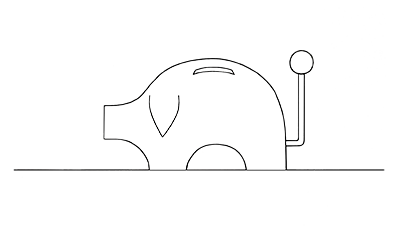
How: Charge customers up front before covering associated expenses
Why: Generating revenue faster than the need to pay suppliers helps produce negative working capital, resulting in increased liquidity and the ability to amortize debt or fund investments.
The Cash Machine pattern involves operating a company with a negative cash conversion cycle, whereby revenue is generated more quickly than payments to suppliers for goods are required. This model is generally not visible to customers, but has significant implications for the business.
| Cash conversion cycle = | Inventory conversion period + Receivables conversion period – Payables conversion period |
By running a negative cash conversion cycle, a business can generate additional liquidity that can be used for a variety of purposes, such as paying off debts or making new investments. This can help the company reduce its interest payments or accelerate growth.
To achieve a negative cash conversion cycle, there are two key levers to consider. First, the business should aim to secure generous payment terms with suppliers. Second, it is important to ensure that customers pay promptly. A build-to-order strategy or very short stock turnover time can also help to realize this goal by minimizing the time that goods spend in inventory.
Where did the Cash Machine business model pattern originate from?
The Cash Machine pattern has a long history, dating back to the use of cheques as a non-cash form of payment. When a cheque is written, the bank acts as an intermediary between the person writing the cheque (the drawer) and the person receiving the money (the payee). The bank collects the funds from the drawer and then issues them to the payee when the cheque is cashed. This creates a negative cash conversion cycle for the bank, as it is able to generate revenue before having to finance any expenses.
Cheques gained popularity in Europe in the early 14th century, as the economic boom of the time increased the need for non-cash payment methods among traders. Another example of the Cash Machine pattern can be found in the development of the traveller’s cheque by American Express (AmEx) in 1891. The idea for this product came about when an AmEx employee traveling abroad struggled to obtain cash. The first traveller’s cheque was cashed on August 5, 1891 by William C. Fargo, nephew of AmEx co-founder William G. Fargo, in Leipzig, Germany.
Applying the Cash Machine business model
The Cash Machine pattern can be highly effective for businesses that operate on a build-to-order basis or have secured favorable payment terms with suppliers. By receiving payments for services rendered as quickly as possible and delaying payments to suppliers as long as possible, a company can generate additional liquidity that is available for use at its discretion. This model is only viable if the business’s offerings are perceived as having high value by customers, such as through an online build-to-order process.
One example of the success of the Cash Machine pattern is Dell, which was able to leverage this model to great effect. Another option is to combine the Cash Machine pattern with the Subscription pattern, whereby customers pay upfront but receive products or services at a later date.
Real life Cash Machine examples
Groupon
As customers buy vouchers or coupons up front, Groupon collects customer payments immediately, but pays businesses later.
PayPal
Processing payments for its vendors, PayPal holds money until asserted genuine and requested for transfer to the merchant.
Dell
Dell was the first company in the field of information technology to utilize a build-to-order strategy in the 1980s, allowing it to achieve a highly negative cash conversion cycle and finance its growth. When the company was founded in 1984, its founder Michael Dell had only $1,000 in seed capital, so large investments or a costly inventory could have resulted in bankruptcy.
Amazon
Amazon is another company that effectively employs the Cash Machine pattern. It typically realizes a negative cash conversion cycle for 14 days by ensuring a rapid turnover of inventory and negotiating generous payment terms with suppliers. This allows Amazon to delay payments to suppliers until it has been paid by customers for the goods they have purchased.
Trigger Questions
- How can you make a build-to-order process beneficial to the customer?
- Can you postpone completion of products until they have been paid for?
- Is it possible to renegotiate contracts with suppliers?
- Can we delay the completion of our products and services until they have been paid for?
- How would Dell manage our business?
Proven business models that have driven success for global leaders across industries. Rethink how your business can create, deliver, and capture value.
Get your deck!Related plays
- Business Model Navigator by Karolin Frankenberger and Oliver Gassmann
- What Is Cash Conversion Cycle? Amazon Cash Machine Business Strategy In A Nutshell by Gennaro Cuofano

